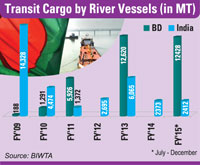
Bangladeshi water vessels are now carrying more transit cargoes than Indian ones through Bangladesh's rivers, as the transit deal between the two neighbours stimulated the trade.
Statistics available with Bangladesh Inland Water Transport Authority (BIWTA) revealed the waterway transit and trade scenario.
The BIWTA shows that in the first half of the current fiscal year, 2014-15, about 12,428 tonnes of cargoes had been carried by Bangladeshi vessels.
At the same time, the quantity of cargoes carried by Indian vessels stood at 2,412 tonnes.
In the previous fiscal year (FY '14), all of 2373 tonnes of transit cargoes were ferried by Indian vessels.
The transport of transit cargoes is guided by the Protocol on Inland Water Transit and Trade (PIWTT), which was revised in May last year. The revised protocol was formally signed during the Indian Prime Minister's visit to Bangladesh in the first week of June.
The protocol has two components-one for bilateral trade and the other for the transit trade.
The transit-trade arrangement allows transportation of goods between West Bengal and Assam and other parts of Northeast India through the Bangladeshi river system.
The BIWTA statistics also shows that Bangladeshi vessels did not carry any transit cargo in the FY '12, when Indian vessels carried all of 2695 tonnes of cargoes.
As per its statistics, in the last six and a half years Bangladeshi vessels carried 32,428 tonnes of transit cargoes and Indian vessels 33,719 tonnes.
Bangladesh and India formally introduced coastal shipping service this year to increase both bilateral and transit-cargo movements between the two countries.
Currently, Prantik Bangladesh-India Xpress, or Prantik BIX, connects Kolkata with the seaport of Chittagong by using the vessel Rodella. Already the vessel has completed five trips on a trial basis.
Md Golam Sarwar, managing director of Prantik, told FE that although initial response was not as good as expected, the situation would improve in near future.
"Bangladesh-India bilateral trade is heavily dependent on road-based cargo movement and our challenge is to transform a part of the road-based cargo movement into sea-based movement," said Mr Sarwar.
He also said annually around 3.5 million tonnes of cargoes are transported through Beanpole and Sonamasjid land ports. If 10 to 15 per cent of the load could be shifted to the sea route, it would not only reduce trade cost but also increase business through coastal shipping.
He thinks the vessel, Rodella, could as well call at the inland river ports like Narayanganj, Ashuganj and Mongla and so to handle transit cargoes on river routes.
When it comes to Bangladesh-India bilateral trade through inland river routes, Bangladeshi vessels dominate the freight traffic.
The BIWTA statistics also shows that during the last six and a half years, about 9.4 million tonnes of cargoes were transported between the two countries through river routes. Of the haulage, 98 per cent was carried by Bangladeshi vessels.
Traffic on river routes is mostly one-way while carrying bilateral trade cargo and it is from India to Bangladesh where one commodity, fly ash, is the single-largest import.
© 2024 - All Rights with The Financial Express
